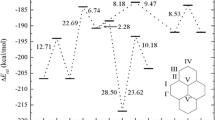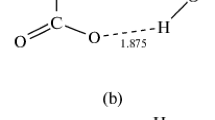Abstract
The properties of complexes formed by phenol and K+, Na+, Li+ and Mg2+ in the presence of up to four water molecules have been studied by means of computational methods. The interaction becomes stronger as the size of the cation decreases, showing almost no preference between coordinating to the aromatic ring or to the hydroxyl oxygen. As water molecules are introduced, a variety of stable structures arise, where water molecules establish hydrogen bonds among themselves and with the hydroxyl group of phenol. For the most polarizing cations, the strong cation···water interaction gives most stable minima corresponding to arrangements with water molecules and phenol coordinated directly to the cation, with no significant hydrogen bonds among them. However, in Na+ complexes and especially in K+ ones, the interaction with the cation is weaker, so hydrogen bond formation starts to be competitive as more water molecules are included, the most stable minima corresponding to structures where not all water molecules or phenol are directly bound to the cation. This behavior is also reflected on the predicted vibrational spectra, which agree with those determined experimentally. Up to three water molecules, only for K+ and to a less extent Na+, stable minima are found showing red-shifted O–H stretching bands corresponding to water···water and water···phenol hydrogen bonds. With four water molecules, at least one water molecule is located in a second solvation shell, all cations exhibiting red-shifted bands.








Similar content being viewed by others
References
Hobza P, Zaradnik R (1988) Intermolecular complexes: the role of van der Waals systems in physical chemistry and the biodisciplines. Elsevier, Amsterdam
Lehn J-M (1995) Supramolecular chemistry: concepts and perspectives. VCH, cop., Weinheim
Tsuzuki S, Uchimaru T (2006) Magnitude and physical origin of intermolecular interactions of aromatic molecules: recent progress of computational studies. Curr Org Chem 10(7):745–762
Meyer EA, Castellano RK, Diederich F (2003) Interactions with aromatic rings in chemical and biological recognition. Angew Chem Int Ed 42(11):1210–1250. doi:10.1002/anie.200390319
Salonen LM, Ellermann M, Diederich F (2011) Aromatic rings in chemical and biological recognition: energetics and structures. Angew Chem Int Ed 50(21):4808–4842. doi:10.1002/anie.201007560
Scrutton NS, Raine AR (1996) Cation-pi bonding and amino-aromatic interactions in the biomolecular recognition of substituted ammonium ligands. Biochem J 319(1):1–8
Dougherty DA (2007) Cation-π interactions involving aromatic amino acids. J Nutr 137:1504S–1508S
Waters ML (2004) Aromatic interactions in peptides: impact on structure and function. Biopolymers (Peptide Science) 76(5):435–445. doi:10.1002/bip.20144
Ma JC, Dougherty DA (1997) The cation-π interaction. Chem Rev 97(5):1303–1324. doi:10.1021/cr9603744
Gallivan JP, Dougherty DA (1999) Cation-π interactions in structural biology. Proc Nart Acad Sci USA 96:9459–9464
Gallivan JP, Dougherty DA (2000) A computational study of cation-π interactions vs salt bridges in aqueous media: implications for protein engineering. J Am Chem Soc 122:870–874
Anderson MA, Ogbay B, Arimoto R, Sha W, Kisselev OG, Cistola DP, Marshall GR (2006) Relative strength of cation-π vs salt-bridge interactions: the Gtα(340–350) peptide/rhodopsin system. J Am Chem Soc 128(23):7531–7541. doi:10.1021/ja058513z
Berry BW, Elvekrog MM, Tommos C (2007) Environmental modulation of protein cation-π interactions. J Am Chem Soc 129(17):5308–5309. doi:10.1021/ja068957a
Hughes RM, Benshoff ML, Waters ML (2007) Effects of chain length and N-methylation on a cation-π interaction in a β-hairpin peptide. Chem Eur J 13:5753–5764. doi:10.1002/chem.200601753
Hughes RM, Waters ML (2005) Influence of N-methylation on a cation-π interaction produces a remarkably stable β-hairpin peptide. J Am Chem Soc 127:6518–6519. doi:10.1021/ja0507259
Hughes RM, Waters ML (2006) Effects of lysine acetylation in a β-hairpin peptide: comparison of an amide-π and a cation-π interaction. J Am Chem Soc 128:13586–13591. doi:10.1021/ja0648460
Hughes RM, Waters ML (2006) Arginine methylation in a β-hairpin peptide: implications for Arg-π interactions, ΔCp, and the cold denatured state. J Am Chem Soc 128:12735–12742. doi:10.1021/ja061656g
Khandelia H, Kaznessis YN (2006) Cation-π interactions stabilize the structure of the antimicrobial peptide indolicidin near membranes: molecular dynamics simulations. J Phys Chem B 111(1):242–250. doi:10.1021/jp064776j
Mason PE, Dempsey CE, Neilson GW, Kline SR, Brady JW (2009) Preferential interactions of guanidinum ions with aromatic groups over aliphatic groups. J Am Chem Soc 131(46):16689–16696. doi:10.1021/ja903478s
Riemen AJ, Waters ML (2009) Design of highly stabilized β-hairpin peptides through cation-π interactions of lysine and N-methyllysine with an aromatic pocket. Biochemistry 48(7):1525–1531. doi:10.1021/bi801706k
Shi Z, Olson CA, Kallenbach NR (2002) Cation-π interaction in model α-helical peptides. J Am Chem Soc 124(13):3284–3291. doi:10.1021/ja0174938
Tatko CD, Waters ML (2003) Cation pi en beta-hairpin. Protein Sci 12:2443–2452
Kim D, Hu S, Tarakeshwar P, Kim KS, Lisy JM (2003) Cation-π interactions: a theoretical investigation of the interaction of metallic and organic cations with alkenes, arenes, and heteroarenes. J Phys Chem A 107:1228–1238. doi:10.1021/jp0224214
Cabarcos OM, Weinheimer CJ, Lisy JM (1999) Size selectivity by cation-π interactions: solvation of K+ and Na+ by benzene and water. J Chem Phys 110:8429–8435. doi:10.1063/1.478752
Cabarcos OM, Weinheimer CJ, Lisy JM (1998) Competitive solvation of K+ by benzene and water: cation-π interactions and π-hydrogen bonds. J Chem Phys 108:5151–5154. doi:10.1063/1.476310
Xiao JT, Wei LZ, Cui M, Xiao ML, Jian DG, Silman I, Sussman JL, Hua LJ, Ru YJ, Chen KX (2001) Noncovalent interaction or chemical bonding between alkaline earth cations and benzene? A quantum chemistry study using MP2 and density-functional theory methods. Chem Phys Lett 349:113–122
Adamo C, Berthier G, Savinelli R (2004) Solvation effects on cation–p interactions: a test study involving the quaternary ammonium ion. Theor Chem Acc 111(2):176–181. doi:10.1007/s00214-003-0507-6
Xu Y, Shen J, Zhu W, Luo X, Chen K, Jiang H (2005) Influence of the water molecule on cation-π interaction: ab initio second order Møller–Plesset perturbation theory (MP2) calculations. J Phys Chem B 109(12):5945–5949. doi:10.1021/jp044568w
Cabaleiro-Lago EM, Rodriguez-Otero J, Pena-Gallego A (2011) Effect of microhydration on the guanidinium[centered ellipsis]benzene interaction. J Chem Phys 135(21):214301–214309
Reddy AS, Zipse H, Sastry GN (2007) Cation-π interactions of bare and coordinatively saturated metal ions: contrasting structural and energetic characteristics. J Phys Chem B 111(39):11546–11553. doi:10.1021/jp075768l
Vijay D, Zipse H, Sastry GN (2008) On the cooperativity of cation-π and hydrogen bonding interactions. J Phys Chem B 112(30):8863–8867. doi:10.1021/jp804219e
Rao JS, Zipse H, Sastry GN (2009) Explicit solvent effect on cation-π interactions: a first principle investigation. J Phys Chem B 113(20):7225–7236. doi:10.1021/jp900013e
Sponer J, Sponer JE, Leszczynski J (2000) Cation-π and amino-acceptor interactions between hydrated metal cations and DNA bases. A quantum-chemical view. J Biomol Struct Dyn 17:1087–1096
Leavens FMV, Churchill CDM, Wang S, Wetmore SD (2011) Evaluating how discrete water molecules affect protein–DNA π–π and π + –π stacking and T-shaped interactions: the case of histidine-adenine dimers. J Phys Chem B 115(37):10990–11003. doi:10.1021/jp205424z
Larrucea J, Rezabal E, Marino T, Russo N, Ugalde JM (2010) Ab initio study of microsolvated Al3+-aromatic amino acid complexes. J Phys Chem B 114:9017–9022. doi:10.1021/jp101874p
Miller DJ, Lisy JM (2006) Hydration of ion-biomolecule complexes: ab initio calculations and gas-phase vibrational spectroscopy of K+ (indole)m (H2O)n. J Chem Phys 124(18):184301–184307
Vaden TD, Lisy JM (2004) Characterization of hydrated Na + (phenol) and K + (phenol) complexes using infrared spectroscopy. J Chem Phys 120:721–730. doi:10.1063/1.1630962
Amunugama R, Rodgers MT (2002) The influence of substituents on cation-π interactions. 4. Absolute binding energies of alkali metal cation-phenol complexes determined by threshold collision-induced dissociation and theoretical studies. J Phys Chem A 106:9718–9728. doi:10.1021/jp0211584
Watanabe H, Iwata S (1996) Theoretical studies of geometric structures of phenol-water clusters and their infrared absorption spectra in the O–H stretching region. J Chem Phys 105(2):420–431
Gerhards M, Kleinermanns K (1995) Structure and vibrations of phenol(H2O)2. J Chem Phys 103(17):7392–7400
Wu R, Brutschy B (2004) Study on the structure and intra- and intermolecular hydrogen bonding of 2-methoxyphenol. (H2O)n (n = 1,2). Chem Phys Lett 390(1–3):272–278
Benoit DM, Clary DC (2000) Quantum simulation of phenol-water clusters. J Phys Chem A 104(23):5590–5599
Ebata T, Fujii A, Mikami N (1996) Structures of size selected hydrogen-bonded phenol-(H2O)n clusters in S0, S1 and ion. Int J Mass Spectrom 159:111–124
Janzen C, Spangenberg D, Roth W, Kleinermanns K (1999) Structure and vibrations of phenol(H2O)7,8 studied by infrared-ultraviolet and ultraviolet–ultraviolet double-resonance spectroscopy and ab initio theory. J Chem Phys 110(20):9898–9907
Roth W, Schmitt M, Jacoby C, Spangenberg D, Janzen C, Kleinermanns K (1998) Double resonance spectroscopy of phenol(H2O)1–12: evidence for ice-like structures in aromatic-water clusters? Chem Phys 239(1–3):1–9
Sodupe M, Oliva A, Bertran J (1997) Theoretical study of the ionization of phenol-water and phenol-ammonia hydrogen-bonded complexes. J Phys Chem A 101(48):9142–9151
Kupper J, Westphal A, Schmitt M (2001) The structure of the binary phenol-methanol cluster: a comparison of experiment and ab initio theory. Chem Phys 263(1):41–53
Kryachko ES, Nguyen MT (2002) fenol acetionitrilo. J Phys Chem A 106:4267–4271
Cabaleiro-Lago EM, Pena-Gallego A, Rodriguez-Otero J (2008) Study of the interaction in clusters formed by phenol and CH3X (X = CN, F, Cl) molecules. J Chem Phys 128(19):194311–194318
Michaux C, Wouters J, Perpete EA, Jacquemin D (2008) Microhydration of protonated glycine: an ab initio family tree. J Phys Chem B 112(8):2430–2438. doi:10.1021/jp710034r
Michaux C, Wouters J, Perpète EA, Jacquemin D (2008) Stepwise hydration of protonated proline. J Phys Chem B 112(26):7702–7705. doi:10.1021/jp8023155
Yao Y, Chen D, Zhang S, Li Y, Tu P, Liu B, Dong M (2011) Building the first hydration shell of deprotonated glycine by the MCMM and ab initio methods. J Phys Chem B 115(19):6213–6221. doi:10.1021/jp1117097
Prakash M, Subramanian V, Gadre SR (2009) Stepwise hydration of protonated carbonic acid: a theoretical study. The Journal of Physical Chemistry A 113(44):12260–12275. doi:10.1021/jp904576u
Sharma B, Rao JS, Sastry GN (2011) Effect of solvation on ion binding to imidazole and methylimidazole. J Phys Chem A 115(10):1971–1984. doi:10.1021/jp1120492
Boys SF, Bernardi F (1970) The calculation of small molecular interactions by the differences of separate total energies. Some procedures with reduced errors. Mol Phys 19:553–566
Chalasinski G, Szczesniak MM (2000) State of the art and challenges of the ab initio theory of intermolecular interactions. Chem Rev 100(11):4227–4252
Cabaleiro-Lago E, Rodríguez-Otero J, Peña-Gallego Á (2011) Study of the interaction between aniline and CH3CN, CH3Cl and CH3F. Theor Chem Acc 128(4):531–539. doi:10.1007/s00214-010-0789-4
Frisch MJ, Trucks GW, Schlegel HB, Scuseria GE, Robb MA, Cheeseman JR, Scalmani G, Barone V, Mennucci B, Petersson GA, Nakatsuji H, Caricato M, Li X, Hratchian HP, Izmaylov AF, Bloino J, Zheng G, Sonnenberg JL, Hada M, Ehara M, Toyota K, Fukuda R, Hasegawa J, Ishida M, Nakajima T, Honda Y, Kitao O, Nakai H, Vreven T, Montgomery J, Peralta JE, Ogliaro F, Bearpark M, Heyd JJ, Brothers E, Kudin KN, Staroverov VN, Kobayashi R, Normand J, Raghavachari K, Rendell A, Burant JC, Iyengar SS, Tomasi J, Cossi M, Rega N, Millam JM, Klene M, Knox JE, Cross JB, Bakken V, Adamo C, Jaramillo J, Gomperts R, Stratmann RE, Yazyev O, Austin AJ, Cammi R, Pomelli C, Ochterski JW, Martin RL, Morokuma K, Zakrzewski VG, Voth GA, Salvador P, Dannenberg JJ, Dapprich S, Daniels AD, Farkas Ö, Foresman JB, Ortiz JV, Cioslowski J, Fox DJ (2009) Gaussian 09. Gaussian, Inc, Wallingford CT
Marshall MS, Steele RP, Thanthiriwatte KS, Sherrill CD (2009) Potential energy curves for cation-π interactions: off-axis configurations are also attractive. J Phys Chem A 113(48):13628–13632. doi:10.1021/jp906086x
Acknowledgments
The authors thank the financial support from the Ministerio de Ciencia e Innovación and the ERDF 2007–2013 (Grant No. CTQ2009-12524). We are also thankful to the Centro de Supercomputación de Galicia (CESGA) for the use of their computers.
Author information
Authors and Affiliations
Corresponding author
Electronic supplementary material
Below is the link to the electronic supplementary material.
214_2012_1290_MOESM1_ESM.docx
Electronic supplementary material The online version of this article contains supplementary material, which is available to authorized users. (DOCX 6,829 kb)
Rights and permissions
About this article
Cite this article
Campo-Cacharrón, A., Cabaleiro-Lago, E.M. & Rodríguez-Otero, J. Effects of microhydration on the characteristics of cation–phenol complexes. Theor Chem Acc 131, 1290 (2012). https://doi.org/10.1007/s00214-012-1290-z
Received:
Accepted:
Published:
DOI: https://doi.org/10.1007/s00214-012-1290-z




